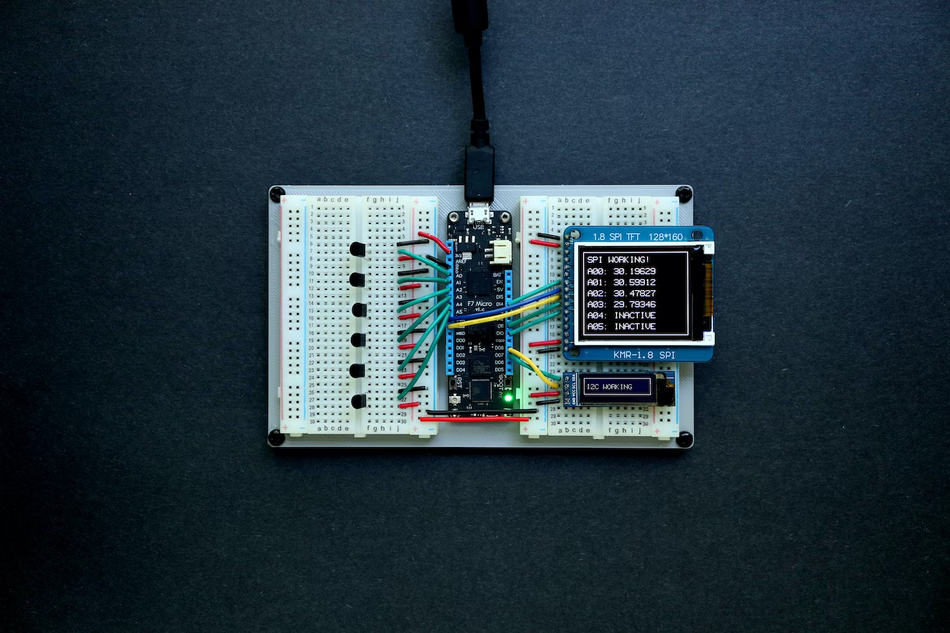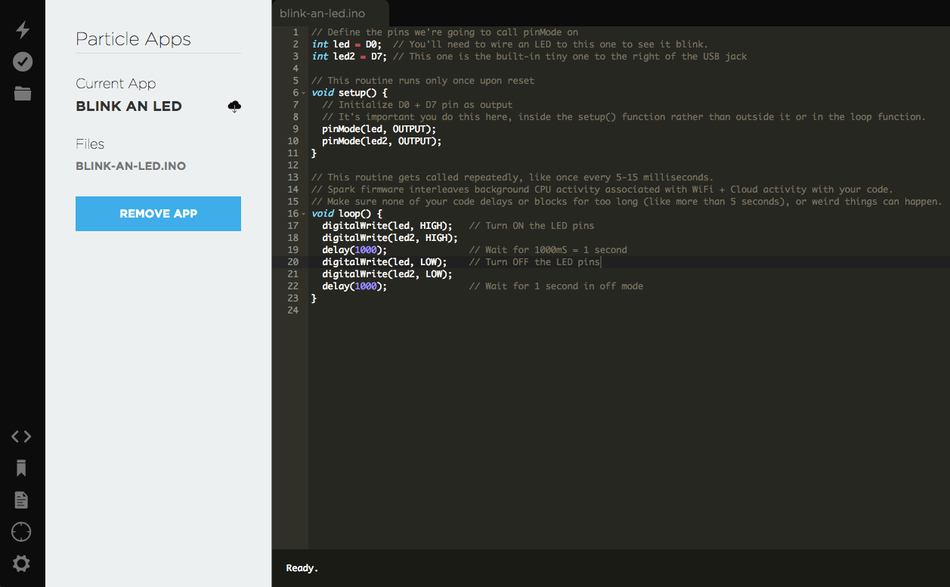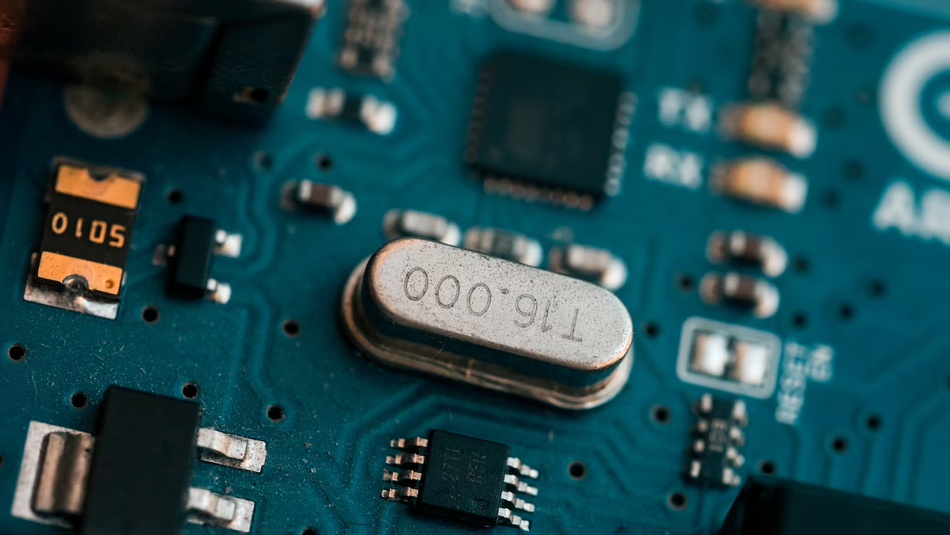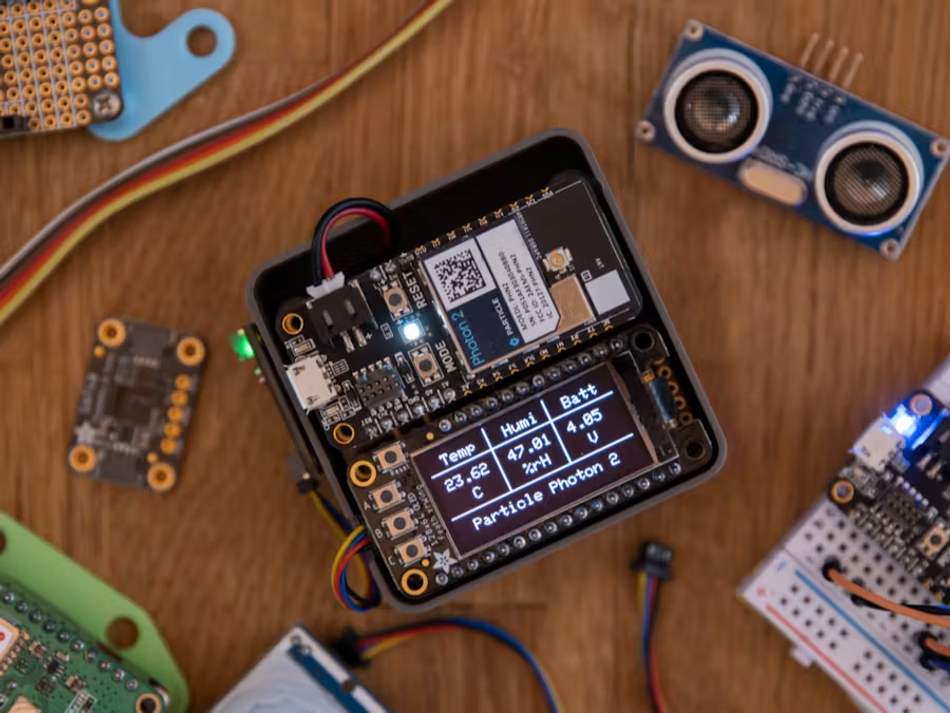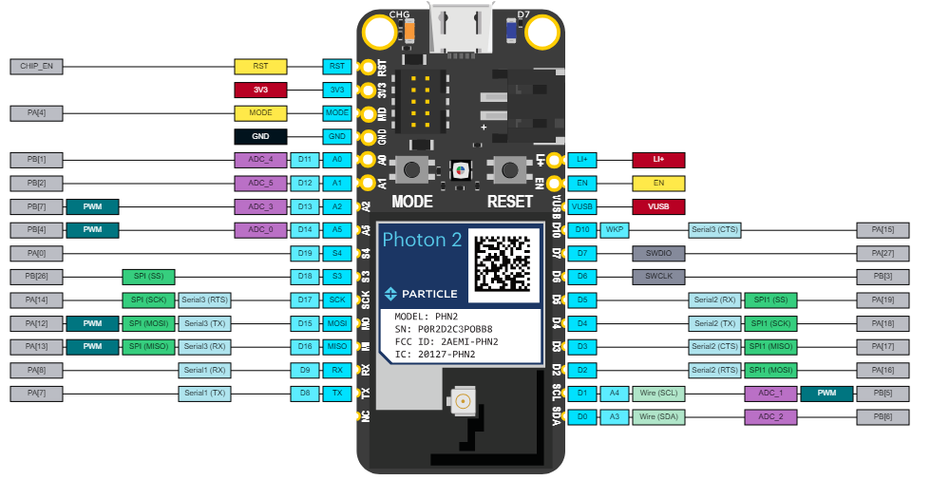Microcontroller-Based IoT Development Kits: Powering the Next Generation of IoT Solutions
In the evolving landscape of IoT, explore how microcontroller-based IoT development kits such as the Particle Photon 2 are driving innovation in product research and development.
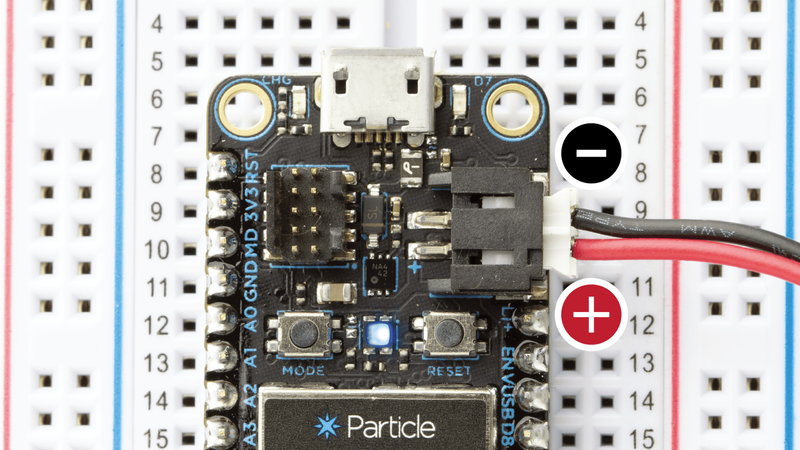
Introduction
The Internet of Things (IoT) — a network of interconnected devices communicating and sharing data — has become an integral part of our digital landscape. Its significance has reached unprecedented heights in our increasingly technologically-driven world, permeating industries from manufacturing to healthcare. A crucial element driving this growth is continuous research and development (R&D) in IoT, pushing boundaries and creating solutions that are more efficient, reliable, and beneficial.
This article sets the stage to discuss how low-cost microcontroller-based IoT development boards and platforms, such as the Particle Photon 2 development kit, are poised to revolutionize IoT product research and fuel advancements in this space.
Understanding Microcontrollers and their Applications in IoT
Microcontrollers are standalone, compact systems on a chip (SoC) comprised of a processor core, memory, and programmable I/O peripherals. In the context of IoT, they offer the capability to process data, interface with sensors, and enable device-to-device communication - all while operating under constrained power and memory conditions.
Different types of microcontrollers offer varying benefits for IoT applications. 8-bit microcontrollers, for instance, are best suited for elementary tasks with minimal data throughput requirements due to their modest computational power and limited memory. 16-bit microcontrollers offer a balance between performance and power consumption, suitable for mid-range applications such as home automation devices. In contrast, 32-bit microcontrollers, with advanced cores like ARM Cortex-M series, cater to more demanding IoT applications requiring higher computational intensity and larger memory footprint, like video processing or advanced data analytics.
Challenges in IoT Product Design and Development
Today, IoT development faces several hurdles that, in many ways, impede its progress. Firstly, the traditionally high costs associated with IoT development have been a significant barrier for startups and small-scale enterprises, limiting opportunities for innovation. Secondly, IoT development often involves the complex task of integrating multiple hardware and software components, requiring specialized skill sets and driving up both costs and development time. Lastly, scalability remains a persistent issue. As IoT applications grow in complexity and size, ensuring they can be effectively scaled without compromising performance or security presents a considerable challenge.
These impediments collectively contribute to a slowing pace of innovation in the IoT field, signaling a clear and urgent need for efficient, cost-effective, and scalable solutions. One such promising avenue lies in the use of low-cost microcontroller-based IoT development boards and platforms.
Microcontroller-based IoT Kits for Accelerating Product Development
Microcontroller-based IoT kits are comprehensive packages comprising a microcontroller and various sensors, actuators, and communication modules, designed to facilitate the creation, development, and prototyping of IoT applications. These kits offer an array of distinct advantages to embedded systems engineers and IoT developers, aiding the advancement and efficient deployment of IoT technologies. Here are some ways in which the development kits support product design:
- Integrated Development Environment (IDE) Compatibility: These development kits are often tailored to seamlessly interface with familiar IDEs that provide a one-stop solution for programming the hardware. This compatibility expedites the process of code writing, debugging, and firmware uploading, bolstering productivity in firmware development cycles. Some of these IDEs support web-based programming, which is advantageous for collaboration and allows for work flexibility while on the go.
- On-Chip Peripherals and Resources: Microcontrollers integrated into these kits come equipped with various onboard resources such as Analog-to-Digital Converters (ADCs), Digital-to-Analog Converters (DACs), Pulse-Width Modulation (PWM) channels, Universal Asynchronous Receiver/Transmitter (UART) interfaces, and Serial Peripheral Interface (SPI) or Inter-Integrated Circuit (I2C) communication channels. These hardware resources, combined with software libraries and drivers, enable engineers to interact with an assortment of external devices and sensors, simplifying hardware interfacing tasks.
- Built-in Communication Modules: IoT development kits often encompass embedded communication modules supporting protocols like IEEE 802.11 (Wi-Fi), IEEE 802.15.4 (Zigbee, Thread), and Bluetooth Low Energy (BLE). These provisions empower engineers to architect applications necessitating wireless data transfer without the hassle of integrating separate wireless modules.
- Power Management Capabilities: Microcontroller-based development kits often allow granular control over power consumption, providing features such as dynamic voltage scaling, multiple power modes, and intelligent peripheral control. These features allow developers to optimize energy utilization and devise power-efficient applications—a quintessential requirement in battery-powered, remote IoT deployments.
- Standardized Interfaces and Protocols: Adherence to industry-standard hardware interfaces and communication protocols by development kit makers promotes interoperability with a multitude of external devices and systems. This standardization eliminates the need for proprietary solutions and boosts design flexibility and scalability.
- Ecosystem and Community Support: Renowned microcontroller platforms and IoT development kits are backed by extensive documentation, software libraries, middleware, and a vibrant community of engineers. This active support ecosystem is an invaluable asset, offering code samples, troubleshooting tips, and hardware design guidelines that facilitate the development process.
- Scalability and Affordability: Microcontroller-based IoT development kits are usually compact and cost-effective, enabling mass deployment in large-scale IoT systems without substantial capital expenditure. Some development kit manufacturers also provide guidelines on how businesses can develop scalable and cost-effective products based on their prototypes.
- Real-Time Operating Systems (RTOS) Support: Some microcontroller-based kits offer support for RTOS, providing preemptive multitasking, inter-task communication, and synchronization primitives. Utilizing RTOSs, engineers can orchestrate sophisticated, time-sensitive applications that demand task scheduling and real-time performance.
In essence, the technical features and capabilities of microcontroller-based IoT development kits are instrumental in expediting the design, prototyping, and deployment of diverse IoT applications, offering embedded system engineers a flexible, efficient, and robust development platform.
The Impact Across Verticals
The transformative potential of IoT has permeated various industry verticals, changing traditional practices and catalyzing unprecedented progress. This section explores concrete case studies in four verticals, demonstrating how these development kits not only streamline the IoT development process but also drive tangible improvements in operational efficiency, resource management, and overall product or service delivery.
Agriculture
In agriculture, IoT development kits using microcontrollers have enabled precision farming. They allow farmers to create real-time soil monitoring systems, facilitating informed irrigation and fertilization decisions, thereby enhancing crop yields and reducing resource waste.
Healthcare
In the healthcare sector, microcontroller IoT kits have been aided the development of remote patient monitoring systems. These systems gather and process vital signs in real time, enabling timely interventions that improve patient outcomes and reduce hospital costs.
Smart Home
In the smart home domain, development kits have simplified the development of home automation systems. These systems can monitor and control lighting, heating, and security at an affordable cost based on user preferences and real-time sensor data.
Manufacturing
Similarly, in manufacturing, development kits have enabled the implementation of Industry 4.0 concepts, facilitating the transformation into smart factories. They allow real-time monitoring and automation of production lines, inventory, and quality control, leading to significant improvements in efficiency and cost reduction.
In each of these verticals, microcontroller-based IoT development kits have streamlined the development process, enabled rapid prototyping, and reduced costs. Their versatility and power efficiency make them an ideal solution for a wide array of IoT applications, driving innovation across sectors.
The Other Alternatives
While microcontroller-based IoT development kits, such as the Particle Photon 2, offer a compelling solution for IoT applications, it's important to note other options available to developers. For instance, Field Programmable Gate Arrays (FPGAs) can offer superior flexibility and performance for certain applications, especially those requiring high-speed digital signal processing.
Suggested reading: FPGA Design: A Comprehensive Guide to Mastering Field-Programmable Gate Arrays
However, they often come with a steeper learning curve and higher costs. ASICs, on the other hand, provide exceptional performance and efficiency, but their development process can be lengthy and prohibitively expensive, making them more suitable for high-volume applications. By comparison, microcontroller-based kits strike a balance between performance, cost, and ease of use, making them a versatile solution for a wide range of IoT applications.
Suggested reading: The Ultimate Guide to ASIC Design: From Concept to Production
The subsequent section delves into a particular microcontroller-based IoT development kit, showcasing its capabilities in assisting product developers in conceiving and implementing novel IoT solutions.
Building Connected IoT Projects with Particle Photon 2
The Particle Photon 2 is a robust development module that integrates a microcontroller and Wi-Fi networking capabilities, designed to succeed the legacy Photon and Argon modules. It costs less than $20 and comes with a form factor similar to its previous iterations but bolsters a range of enhanced features, including support for both 2.4 GHz and 5 GHz Wi-Fi, BLE, and substantially enlarged RAM and flash capacities to facilitate larger applications.
Photon 2 incorporates the same module as Particle P2, a next-gen WiFi module in a Surface-Mounted Device (SMD) package. This streamlines the transition process from a pin-based development module to an SMD mass-production module.
In the wireless department, the Photon 2 is equipped with an 802.11a/b/g/n Wi-Fi system, facilitating operations on both 2.4 GHz and 5 GHz frequencies. It encompasses an integrated PCB antenna, a U.FL connector for the inclusion of an external antenna, and an integrated RF switch. The device also provides support for BLE 5 through the same antenna used for Wi-Fi.
The module is powered by a Realtek RTL8721DM microcontroller unit (MCU) that houses an ARM Cortex M33 CPU clocked at 200 MHz. The module offers a maximum user application size of 2 MB, a RAM of 3 MB available for user applications, and a 2 MB flash file system. The Photon 2 complies with FCC, IC, and CE certifications, which ensures that it meets the crucial safety and performance standards.
From a power perspective, the Photon 2 can be energized through its USB port, demanding at least 500mA. It is compatible with a micro B connector, identical to the original Photon. Furthermore, the module can be powered by a single-cell 3.7V Lithium Polymer (LiPo) due to its onboard LiPo charger, which can charge and power the device when a USB source is connected or power the device from the LiPo exclusively in the absence of a USB.
The Particle Photon 2 is a highly adaptable module that serves as a useful tool for IoT developers and enthusiasts. It's equipped with a diverse set of features and is compatible with a wide array of systems. This makes it suitable for various IoT applications, whether it's for straightforward home automation tasks or more complex industrial systems. When examining its technical specifications, the Particle Photon 2 proves to be a resilient, flexible, and well-performing IoT module for those who need it.
In summary, the Particle Photon 2 represents a significant leap in capabilities and features over its predecessors and offers a number of unique advantages over other development kits on the market. Here are some of the key differentiating features and advantages of Particle Photon 2:
- Superior Processing and Storage Capabilities: Photon 2’s ARM Cortex M33 CPU operating at 200 MHz provides a substantial performance boost over its predecessors and many other development kits. It also boasts a 3 MB of RAM and a 2 MB user application size, allowing for larger and more complex applications than its counterparts.
- Enhanced Wireless Capabilities: Photon 2 is one of the few development kits to support both 2.4 GHz and 5 GHz Wi-Fi, as well as BLE 5.0, providing more flexibility in networking options. This feature is unique as most development kits only support 2.4 GHz Wi-Fi.
- Integrated Battery Support: Unlike many development kits, the Photon 2 comes with a built-in connector for a Li-Po battery and a charger, providing greater versatility for portable applications and projects.
- Improved SPI Performance: The Photon 2 improves upon the SPI timing issues observed in earlier models, providing better support for large Direct Memory Access (DMA) transfers. This enhanced performance is especially crucial for applications that require fast, efficient data transfers.
- Flexible Power Options: The Photon 2 provides flexible power options, including a USB port and a VUSB pin that can be used to power peripherals or the Photon 2 itself. This flexibility in power options makes it more adaptable for a variety of projects.
- Robust Device OS Support: The Device OS in the Photon 2 serves as the foundational software layer that abstracts hardware details, manages system resources, ensures network connectivity, provides security measures, and handles firmware updates.
- Higher Speed I2C Port: The Photon 2 features a high-speed I2C port that can be beneficial for specific applications that require faster data transfer rates.
The Particle Photon 2, with its robust processing power, enhanced wireless capabilities, and unique features, sets itself apart from other development kits on the market. Whether you're an experienced developer looking to build complex applications or a hobbyist seeking a versatile platform for your next project, the Particle Photon 2 is a compelling choice.
Particle has also fostered an active and supportive community (Particle Community) of developers who exchange ideas, provide guidance, and contribute to open-source projects. This collaborative environment encourages interdisciplinary approaches, bringing together experts from various domains such as engineering, design, and business to create innovative IoT solutions. So engineers who embark on using the Photon 2 for development can tap into this rich resource to further accelerate their development.
Conclusion
In conclusion, the widespread adoption of IoT solutions is instrumental in shaping the future of numerous industries, ranging from agriculture and healthcare to home automation and manufacturing. Microcontroller-based IoT development kits such as the Particle Photon 2 stand at the heart of this revolution, providing a potent combination of affordability, versatility, and power efficiency. By eliminating barriers to entry, streamlining the development process, and enabling rapid prototyping, these kits catalyze innovation and pave the way for a more connected, efficient, and sustainable future.
As technology continues to advance, it is expected that the capabilities of these development kits will expand, offering even greater opportunities for exploration and invention in the realm of IoT solutions. Indeed, the current wave of development is just the beginning, and the potential for future growth is vast and exciting. In this context, each vertical that leverages these kits not only contributes to its own advancement but also to the broader evolution of IoT.
About the sponsor: Particle
Particle provides an integrated IoT Platform-as-a-Service that helps businesses connect, manage, and deploy software applications to connected devices, from edge to cloud and back. Over 240k developers, and 160+ Enterprise customers are building on Particle, from fast-growing startups to Fortune 100 companies.
Our expertise goes beyond world-class technology, enabling next-generation business intelligence, insights, and expert customer support to make sure IoT projects succeed. So you can build the business of tomorrow, today.
References
[1] Particle. Photon 2 datasheet. Particle Industries, Inc. Available from: https://docs.particle.io/reference/datasheets/wi-fi/photon-2-datasheet/ (Accessed June 9, 2023).
[2] Hackster. Particle Photon projects. Hackster.io. Available from: https://particle.hackster.io/products/photon (Accessed June 9, 2023).
[3] Core Electronics. Particle Photon. Core Electronics Australia. Available from: https://core-electronics.com.au/particle-photon.html (Accessed June 9, 2023).
[4] PR Newswire. Particle Announces Updated P2 and Photon 2 Wi-Fi Connectivity Offerings for Mass Market Applications. PR Newswire Association LLC. Available from: https://www.prnewswire.com/news-releases/particle-announces-updated-p2-and-photon-2-wi-fi-connectivity-offerings-for-mass-market-applications-301577189.html (Accessed June 9, 2023).

